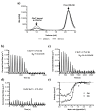Functional and structural characterization of an ECF-type ABC transporter for vitamin B12
- PMID: 29809140
- PMCID: PMC5997447
- DOI: 10.7554/eLife.35828
Functional and structural characterization of an ECF-type ABC transporter for vitamin B12
Abstract
Vitamin B12 (cobalamin) is the most complex B-type vitamin and is synthetized exclusively in a limited number of prokaryotes. Its biologically active variants contain rare organometallic bonds, which are used by enzymes in a variety of central metabolic pathways such as L-methionine synthesis and ribonucleotide reduction. Although its biosynthesis and role as co-factor are well understood, knowledge about uptake of cobalamin by prokaryotic auxotrophs is scarce. Here, we characterize a cobalamin-specific ECF-type ABC transporter from Lactobacillus delbrueckii, ECF-CbrT, and demonstrate that it mediates the specific, ATP-dependent uptake of cobalamin. We solved the crystal structure of ECF-CbrT in an apo conformation to 3.4 Å resolution. Comparison with the ECF transporter for folate (ECF-FolT2) from the same organism, reveals how the identical ECF module adjusts to interact with the different substrate binding proteins FolT2 and CbrT. ECF-CbrT is unrelated to the well-characterized B12 transporter BtuCDF, but their biochemical features indicate functional convergence.
Keywords: E. coli; biochemistry; chemical biology; membrane transport; molecular biophysics; structural biology; transport mechanism; vitamin B12; vitamin trasnport.
© 2018, Santos et al.
Conflict of interest statement
JS, SR, SM, CP, Jt, Jd, AG, DS No competing interests declared
Figures








Similar articles
-
The Different Effects of Substrates and Nucleotides on the Complex Formation of ABC Transporters.Structure. 2019 Apr 2;27(4):651-659.e3. doi: 10.1016/j.str.2019.01.010. Epub 2019 Feb 21. Structure. 2019. PMID: 30799075 Free PMC article.
-
Structural Insights into the Lipid A Transport Pathway in MsbA.Structure. 2019 Jul 2;27(7):1114-1123.e3. doi: 10.1016/j.str.2019.04.007. Epub 2019 May 23. Structure. 2019. PMID: 31130486 Free PMC article.
-
In vitro reconstitution of dynamically interacting integral membrane subunits of energy-coupling factor transporters.Elife. 2020 Dec 22;9:e64389. doi: 10.7554/eLife.64389. Elife. 2020. PMID: 33350937 Free PMC article.
-
ECF-Type ATP-Binding Cassette Transporters.Annu Rev Biochem. 2019 Jun 20;88:551-576. doi: 10.1146/annurev-biochem-013118-111705. Epub 2019 Nov 28. Annu Rev Biochem. 2019. PMID: 30485755 Review.
-
Energy coupling factor-type ABC transporters for vitamin uptake in prokaryotes.Biochemistry. 2012 Jun 5;51(22):4390-6. doi: 10.1021/bi300504v. Epub 2012 May 21. Biochemistry. 2012. PMID: 22574898 Review.
Cited by
-
Genomic analysis of Lactobacillus reuteri WHH1689 reveals its probiotic properties and stress resistance.Food Sci Nutr. 2019 Jan 28;7(2):844-857. doi: 10.1002/fsn3.934. eCollection 2019 Feb. Food Sci Nutr. 2019. PMID: 30847163 Free PMC article.
-
Cofactor Selectivity in Methylmalonyl Coenzyme A Mutase, a Model Cobamide-Dependent Enzyme.mBio. 2019 Sep 24;10(5):e01303-19. doi: 10.1128/mBio.01303-19. mBio. 2019. PMID: 31551329 Free PMC article.
-
Bidirectional ATP-driven transport of cobalamin by the mycobacterial ABC transporter BacA.Nat Commun. 2024 Mar 23;15(1):2626. doi: 10.1038/s41467-024-46917-1. Nat Commun. 2024. PMID: 38521790 Free PMC article.
-
Corrosion-influencing microorganisms in petroliferous regions on a global scale: systematic review, analysis, and scientific synthesis of 16S amplicon metagenomic studies.PeerJ. 2023 Jan 13;11:e14642. doi: 10.7717/peerj.14642. eCollection 2023. PeerJ. 2023. PMID: 36655046 Free PMC article.
-
Characterization of the Streptococcus mutans SMU.1703c-SMU.1702c Operon Reveals Its Role in Riboflavin Import and Response to Acid Stress.J Bacteriol. 2020 Dec 18;203(2):e00293-20. doi: 10.1128/JB.00293-20. Print 2020 Dec 18. J Bacteriol. 2020. PMID: 33077636 Free PMC article.
References
-
- Adams PD, Afonine PV, Bunkóczi G, Chen VB, Davis IW, Echols N, Headd JJ, Hung LW, Kapral GJ, Grosse-Kunstleve RW, McCoy AJ, Moriarty NW, Oeffner R, Read RJ, Richardson DC, Richardson JS, Terwilliger TC, Zwart PH. PHENIX: a comprehensive Python-based system for macromolecular structure solution. Acta Crystallographica Section D Biological Crystallography. 2010;66:213–221. doi: 10.1107/S0907444909052925. - DOI - PMC - PubMed
-
- Banerjee RV, Johnston NL, Sobeski JK, Datta P, Matthews RG. Cloning and sequence analysis of the Escherichia coli metH gene encoding cobalamin-dependent methionine synthase and isolation of a tryptic fragment containing the cobalamin-binding domain. The Journal of Biological Chemistry. 1989;264:13888–13895. - PubMed
Publication types
MeSH terms
Substances
Grants and funding
LinkOut - more resources
Full Text Sources
Other Literature Sources
Medical
Molecular Biology Databases

